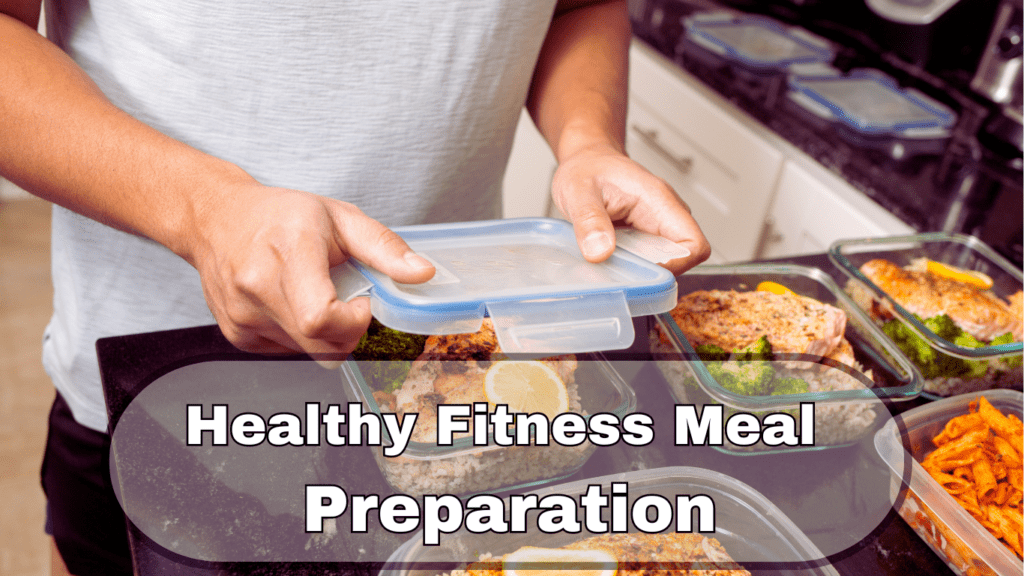Understanding the Challenge: How to Prevent Muscle Loss While Cutting
In this article, we reveal essential strategies on how to prevent muscle loss while cutting, ensuring you shed fat without sacrificing your hard-earned muscle.
Cutting, or being in a caloric deficit, is a critical phase for bodybuilders and fitness enthusiasts striving to shed excess fat and achieve a leaner physique. This process, while essential for reducing body fat, often comes with an inevitable challenge: the risk of losing hard-earned muscle mass. For those who have invested countless hours into strength training and muscle development, this prospect is particularly frustrating. The primary goal during a cutting phase is to reduce body fat while preserving as much muscle as possible. Unfortunately, many find themselves experiencing diminished strength and muscle size as they cut calories. The pressing question then becomes: How can you successfully navigate the challenge of cutting while keeping your muscle mass intact?

Understanding how to prevent muscle loss while cutting involves recognizing that muscle loss during a caloric deficit is more common than many might anticipate. When you reduce your calorie intake, your body starts to seek alternative sources of energy to compensate for the deficit. Ideally, this energy should come from fat stores; however, without proper management, the body may also start breaking down muscle tissue for fuel. This is a significant issue because muscle mass is not only crucial for aesthetics but also plays a vital role in performance and metabolic health. Muscles are metabolically active tissues, which means they burn calories even when you are at rest. Thus, losing muscle not only impacts your physique but also slows down your metabolism, making it more challenging to maintain results and potentially complicating future fat loss efforts.
Subscribe And Get Our Free E-Book:Unlocking The Power Of Nutrition-Supplements, Substitutes, and Superfoods!
Preventing muscle loss is crucial for several reasons beyond just appearance. Maintaining muscle mass helps preserve strength, which is vital for performing everyday activities and intense workouts. Additionally, a well-maintained muscular foundation supports an efficient metabolism, aiding in long-term weight management and overall health. Without this foundation, you may experience a decline in performance, increased fatigue, and a higher risk of injury. Therefore, ensuring that you keep your muscle mass during a cut is essential for staying strong, lean, and healthy over the long term.
In this article, we will explore comprehensive strategies on how to prevent muscle loss while cutting. We will discuss the key components of balancing nutrition, exercise, and recovery to safeguard your muscle mass throughout your cutting phase. By delving into both scientific insights and actionable tips, we aim to provide you with a detailed understanding of how to approach your cutting process effectively. You will gain practical knowledge on how to maintain muscle while losing fat, ensuring that your efforts in the gym are not undone by your dietary choices. By the end of this guide, you will be equipped with the necessary tools and strategies to navigate your cutting phase successfully, keeping your hard-earned muscle intact and achieving your desired results.
Understanding Muscle Loss in a Caloric Deficit
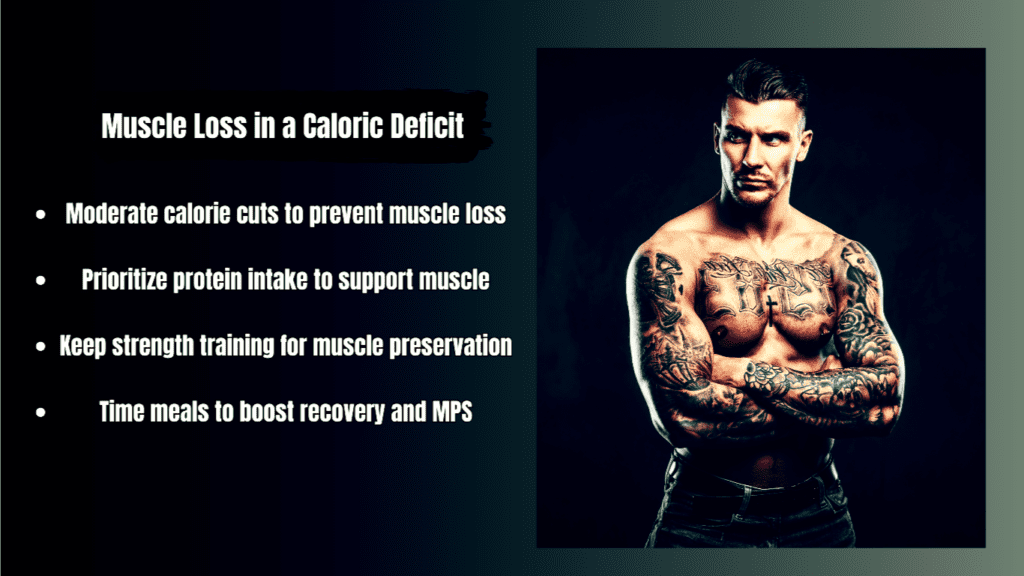
What Happens During Cutting
When embarking on a cutting phase, bodybuilders and fitness enthusiasts aim to shed excess fat while preserving as much muscle as possible. Achieving this balance requires an understanding of the science behind energy balance and muscle preservation. To effectively address how to prevent muscle loss while cutting, it’s essential to grasp the underlying mechanisms at play when the body is in a caloric deficit.
Energy Balance and Caloric Deficit
Energy balance is a fundamental concept in weight management. It refers to the equilibrium between the calories consumed through food and beverages and the calories expended through physical activity and metabolic processes. When you consume more calories than you burn, you’re in a caloric surplus, leading to weight gain. Conversely, when you consume fewer calories than you burn, you’re in a caloric deficit, which is necessary for fat loss.
During a cutting phase, being in a caloric deficit is crucial for reducing body fat. However, the body’s natural response to a caloric deficit is to seek out energy from available reserves. Ideally, this energy should come from stored fat. Unfortunately, the body doesn’t differentiate between fat and muscle when it starts breaking down tissue for fuel. This means that, in addition to fat loss, there’s a risk of also losing muscle mass, especially if strategies to mitigate this effect are not employed.
How to Prevent Muscle Loss While Cutting: Muscle Protein Breakdown vs. Synthesis
Understanding how to prevent muscle loss while cutting involves examining the balance between muscle protein synthesis (MPS) and muscle protein breakdown (MPB). MPS is the process by which the body builds new muscle proteins, whereas MPB refers to the breakdown of existing muscle proteins. For muscle growth and maintenance, MPS must exceed MPB.
During a caloric deficit, there’s often an increase in MPB. This is because the body is in a state of energy stress and may break down muscle tissue to meet its energy demands. To counteract this, MPS must be maximized to ensure that muscle loss is minimized. If MPS cannot keep pace with MPB, muscle loss will occur. Thus, understanding and managing this balance is critical for anyone looking to maintain muscle mass during a cut.
Science-Backed Insight
Several scientific studies and research provide insight into how to prevent muscle loss while cutting and the physiological changes that occur during a caloric deficit.
One key factor is the decrease in muscle protein synthesis that often accompanies a caloric deficit. Research indicates that a reduced calorie intake can lead to lower levels of anabolic hormones, such as testosterone and insulin-like growth factor 1 (IGF-1), which are crucial for muscle growth and repair. Lower levels of these hormones can impair MPS and contribute to muscle loss.
Another aspect to consider is nutrient intake. A study published in the “American Journal of Clinical Nutrition” highlights that insufficient protein intake during a caloric deficit can lead to a higher rate of muscle protein breakdown. Protein is essential for repairing and building muscle tissue, and without adequate amounts, the body will struggle to maintain muscle mass. Therefore, ensuring sufficient protein intake is crucial for mitigating muscle loss.
Moreover, the role of energy availability is crucial. Research has shown that low energy availability can negatively impact muscle mass and performance. Energy availability refers to the amount of energy left for bodily functions after accounting for exercise energy expenditure. When energy availability is low, the body may increase MPB to compensate, leading to muscle loss.
In addition, hormonal changes during a caloric deficit can influence muscle preservation. Lower levels of testosterone, which is critical for muscle growth, can contribute to increased muscle breakdown. Similarly, reduced levels of other hormones like thyroid hormones can slow down metabolism and affect muscle maintenance.
Practical Application
To effectively address how to prevent muscle loss while cutting, it’s important to implement strategies that counteract these physiological challenges. This involves:
- Optimizing Protein Intake: Consuming sufficient protein helps support MPS and reduce MPB. Aim for a high-quality protein source in each meal to ensure your body has the necessary building blocks for muscle repair and growth.
- Strength Training: Regular resistance training is essential for stimulating muscle protein synthesis. Focus on progressive overload to keep challenging your muscles, which helps preserve muscle mass even in a caloric deficit.
- Adequate Energy Intake: While in a caloric deficit, ensure you’re not excessively cutting calories. A moderate deficit helps reduce fat while minimizing muscle loss. Aim for a balanced approach to calorie reduction that supports energy needs without compromising muscle.
- Nutrient Timing: Strategic timing of nutrient intake, such as consuming protein-rich meals around your workouts, can help optimize MPS and support muscle maintenance during cutting.
- Monitoring Hormone Levels: Keeping an eye on your hormonal health through regular check-ups can help identify any imbalances that might affect muscle preservation. Addressing these imbalances with the help of a healthcare provider can support better muscle maintenance.
By understanding these physiological processes and implementing effective strategies, you can better manage your cutting phase and achieve your goal of reducing body fat while preserving muscle mass. The key to success lies in balancing your approach to nutrition, exercise, and overall energy management to ensure that you maintain your hard-earned muscle throughout your cutting journey.
Preventing Muscle Loss On A Cut Video
Key Strategies to Prevent Muscle Loss While Cutting
When undertaking a cutting phase, the primary goal is to reduce body fat while preserving as much muscle mass as possible. Achieving this balance requires a thoughtful approach that addresses several key areas. In this section, we will delve into the essential strategies for how to prevent muscle loss while cutting. We’ll cover the optimal caloric deficit, the importance of protein intake, effective strength training, and the role of cardio. By understanding and implementing these strategies, you can navigate your cutting phase more effectively and retain your hard-earned muscle.
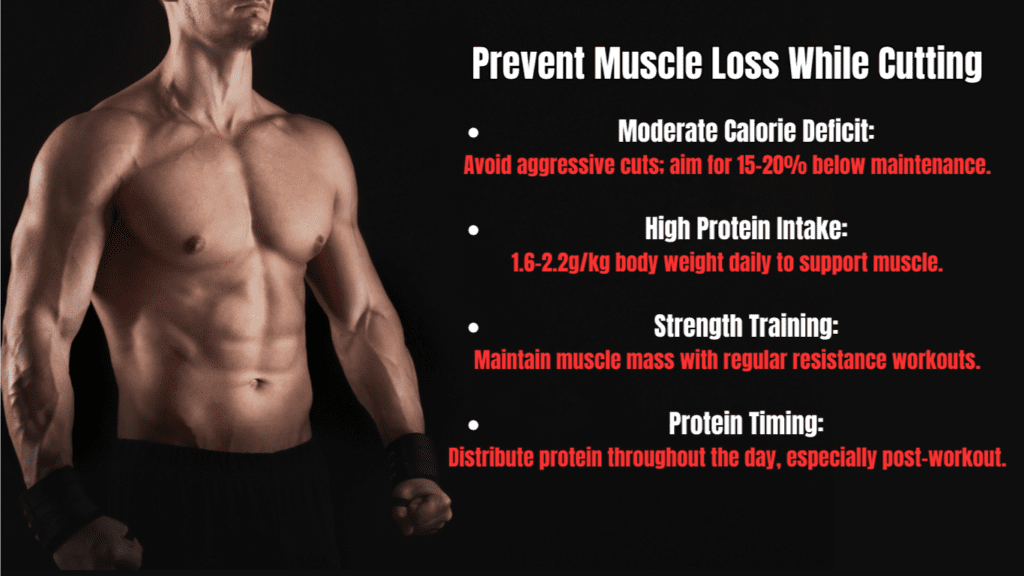
Optimal Caloric Deficit
One of the most crucial aspects of how to prevent muscle loss while cutting is managing your caloric deficit. The goal is to create a calorie shortfall that encourages fat loss without sacrificing muscle.
Avoid Aggressive Deficits: Drastic reductions in calorie intake might seem like an efficient way to lose fat quickly, but they can also lead to significant muscle loss. When your body is deprived of calories at an extreme level, it will turn to muscle tissue for energy, especially if you’re not providing adequate protein and exercise. To maintain muscle mass while cutting, aim for a modest deficit—generally around 15-20% below your maintenance calories. This approach allows for steady fat loss while minimizing the risk of muscle breakdown.
Calculating Deficit: To determine an appropriate calorie deficit, start by calculating your maintenance calories—the number of calories required to maintain your current weight. Various apps and online calculators can assist with this. You can use tools like MyFitnessPal or Cronometer, which require you to input factors such as age, weight, height, activity level, and fitness goals. These calculators will estimate your daily caloric needs and help you set a realistic deficit.
How to Prevent Muscle Loss While Cutting: Prioritize Protein Intake
Protein plays a pivotal role in how to prevent muscle loss while cutting. It is crucial for maintaining muscle protein synthesis (MPS) and reducing muscle protein breakdown (MPB).
Protein Needs While Cutting: During a caloric deficit, protein becomes even more critical. Aim to consume about 1.6 to 2.2 grams of protein per kilogram of body weight daily. This range supports muscle maintenance and growth while in a deficit. For example, if you weigh 70 kilograms (154 pounds), your daily protein intake should be between 112 and 154 grams.
Why Protein Timing Matters: The timing of protein intake can also influence muscle preservation. Distributing your protein intake evenly throughout the day helps maximize MPS. Pay special attention to consuming protein-rich meals both post-workout and pre-sleep. After exercise, your muscles are primed for repair and growth, making it an optimal time for protein consumption. Similarly, consuming protein before bed provides your body with the necessary amino acids to support muscle recovery during sleep.
Quality of Protein Sources: The quality of the protein you consume is equally important. High-quality protein sources include lean meats, fish, eggs, whey protein, and casein. These sources provide all essential amino acids needed for muscle repair and growth. For those following a plant-based diet, options like tofu, tempeh, legumes, and quinoa can also supply adequate protein. Combining different plant sources can ensure you get a complete amino acid profile.
Comparison of Diet Strategies for Muscle Preservation and Fat Loss Chart:
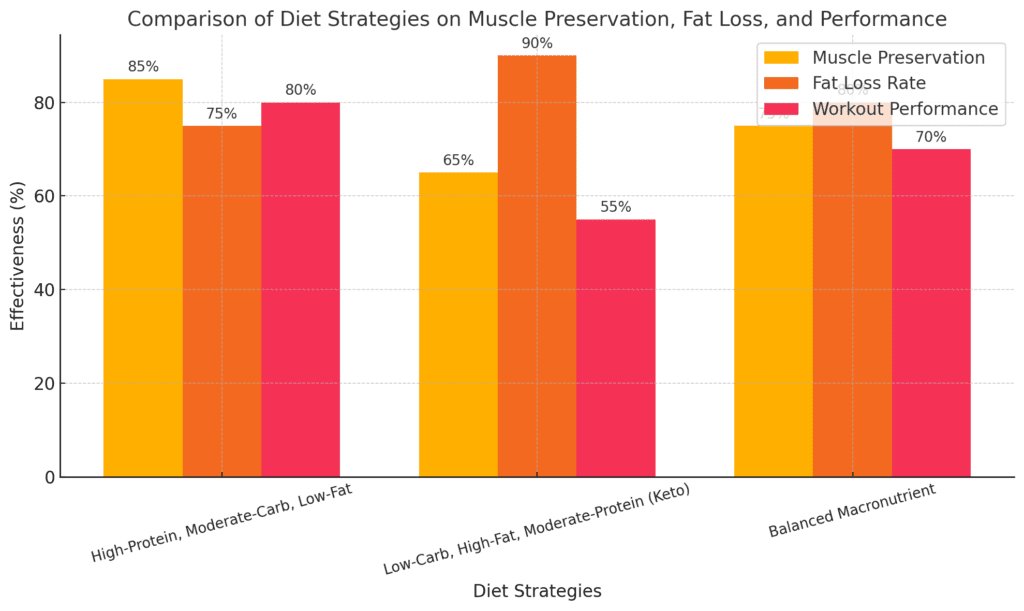
Strength Training to Preserve Muscle
Strength Training is a fundamental component of how to prevent muscle loss while cutting. It provides the necessary stimulus to maintain muscle mass, even when you’re in a caloric deficit.
The Importance of Resistance Training: Engaging in regular resistance training is crucial for signaling your body to preserve muscle tissue. Research shows that weight training helps maintain muscle mass and strength by stimulating MPS. By continuously challenging your muscles, you signal your body that the muscle is needed, which can counteract the effects of a caloric deficit.
Training Variables: When structuring your workouts during a cut, consider factors such as frequency, intensity, and volume. Aim for strength training sessions 3-5 times per week, focusing on major muscle groups. Intensity should be high enough to challenge your muscles—typically in the 6-12 rep range for most exercises. This range is effective for maintaining muscle mass because it balances weight and repetitions, creating sufficient muscle tension.
Progressive Overload & Maintenance: To continue making progress, incorporate progressive overload—gradually increasing the weight or intensity of your workouts. This helps keep your muscles challenged and prevents adaptation. However, be cautious not to overtrain, as excessive training can lead to fatigue and injury. Monitor your body’s response and adjust your training load accordingly to maintain muscle without risking overtraining.
How to Prevent Muscle Loss While Cutting: Don’t Overdo Cardio
Cardio can play a role in fat loss, but it’s important to balance it with muscle preservation strategies.
Cardio’s Role in Fat Loss: While cardio helps burn calories and contributes to fat loss, excessive cardio can lead to muscle breakdown. This is because prolonged or intense cardio sessions can increase muscle protein breakdown if not properly balanced with strength training and adequate nutrition.
Smart Cardio Choices: Opt for moderate cardio—such as low-impact, low-intensity steady-state (LISS) cardio. LISS includes activities like walking, light jogging, or cycling at a steady pace, which helps burn fat without significantly impacting muscle mass. On the other hand, high-intensity interval training (HIIT) should be used sparingly. While HIIT is effective for burning calories, its intense nature can contribute to muscle catabolism if performed excessively. Balance HIIT with strength training and adequate recovery to minimize its impact on muscle mass.
Mastering how to prevent muscle loss while cutting involves a balanced approach to nutrition, exercise, and overall calorie management. By setting a modest caloric deficit, prioritizing adequate protein intake, engaging in regular strength training, and moderating cardio, you can effectively reduce body fat while preserving muscle mass. Implement these strategies consistently to achieve your cutting goals without sacrificing your hard-earned muscle.
Supporting Muscle Retention with Nutrition
Maintaining muscle mass during a cutting phase requires more than just a strategic exercise regimen; it also hinges on effective nutrition. Understanding how to prevent muscle loss while cutting involves not only managing calorie intake but also optimizing your macronutrient distribution, timing your nutrients correctly, and incorporating beneficial supplements. In this section, we’ll explore how to use nutrition to support muscle retention and provide practical tips for ensuring you keep your muscle mass intact throughout your cutting phase.
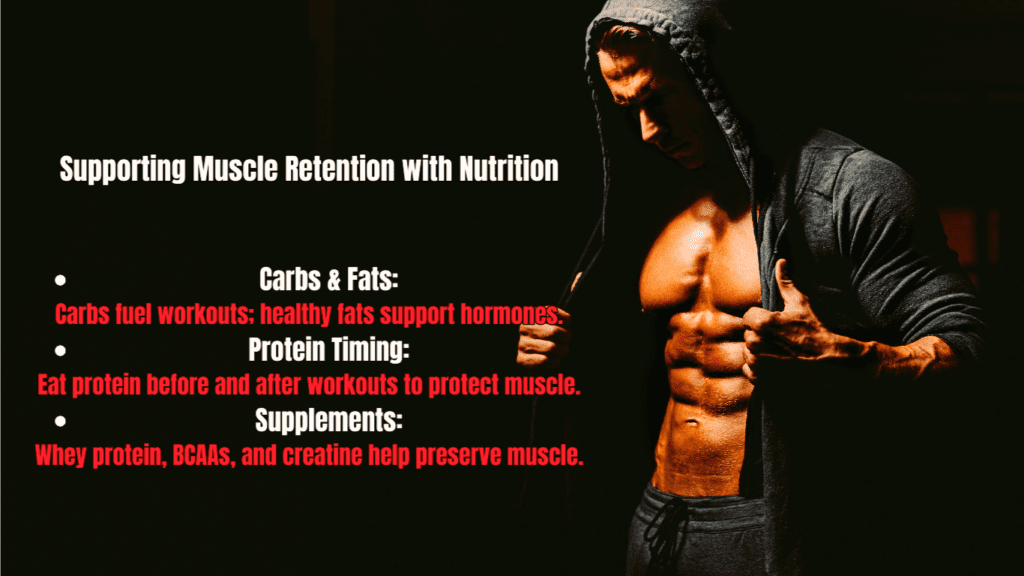
Balanced Macronutrient Distribution
Carbohydrate Importance: Carbohydrates are often misunderstood in the context of cutting, but they play a critical role in preserving muscle mass. Carbs are the primary fuel source for high-intensity workouts, which are essential for maintaining muscle. When you’re in a caloric deficit, your body is more likely to use muscle glycogen (stored carbohydrates) as an energy source if you don’t consume enough carbs. This can lead to muscle loss, as your body might break down muscle tissue to meet its energy needs.
To counteract this, ensure you include a sufficient amount of carbohydrates in your diet. Carbs help spare muscle glycogen during intense exercise, allowing your body to rely more on fat stores for energy. This approach not only supports performance but also helps preserve muscle mass. Aim to consume complex carbohydrates, such as whole grains, fruits, and vegetables, which provide sustained energy and essential nutrients.
Healthy Fats for Hormonal Balance: Dietary fats are another crucial component in how to prevent muscle loss while cutting. Healthy fats support overall hormonal health, which is vital for muscle preservation. Fats play a significant role in the production of hormones like testosterone, which are essential for muscle growth and repair. Low-fat diets can lead to decreased testosterone levels, potentially impairing muscle retention and overall performance.
Incorporate sources of healthy fats into your diet, such as avocados, nuts, seeds, and fatty fish. These fats not only support hormone production but also contribute to overall health. Maintaining a balanced intake of fats can help ensure that your hormonal levels remain optimal, which supports muscle preservation even while cutting.
A balanced macronutrient distribution is key to supporting muscle retention during cutting. The chart below outlines the ideal macronutrient ratios for optimizing muscle preservation, hormonal balance, and workout performance while in a caloric deficit.
Optimal Macronutrient Distribution for Muscle Retention During Cutting Chart:
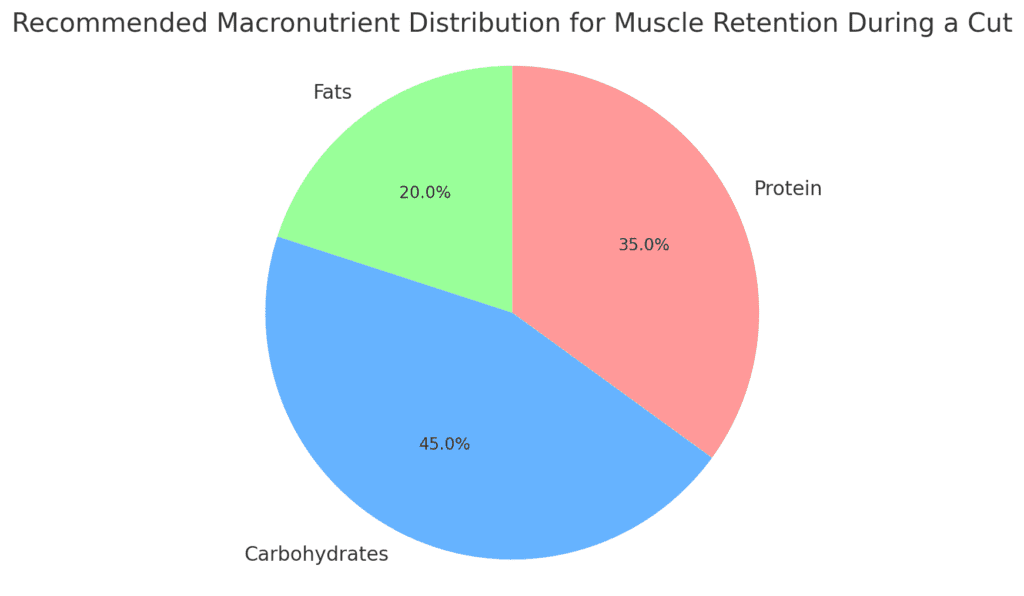
Nutrient Timing
Pre and Post-Workout Nutrition: The timing of your nutrient intake can significantly impact how to prevent muscle loss while cutting. Consuming the right nutrients before and after your workouts helps support muscle maintenance and recovery.
Pre-Workout Nutrition: Eating a combination of carbohydrates and protein before your workout provides the energy needed for intense exercise and helps protect muscle mass. A pre-workout meal should ideally include easily digestible carbs and a moderate amount of protein to fuel your workout and prepare your muscles for the strain. For example, a banana with a scoop of whey protein or a small serving of oatmeal with Greek yogurt can be effective.
Post-Workout Nutrition: After exercise, your muscles are primed for recovery and repair. Consuming a meal or snack rich in protein and carbohydrates within 30-60 minutes post-workout helps replenish glycogen stores and promotes muscle protein synthesis. This practice not only aids in muscle recovery but also reduces muscle breakdown. Consider options like a protein shake with a piece of fruit or a chicken breast with sweet potatoes.
Intermittent Fasting and Muscle Loss: Intermittent fasting (IF) is a popular dietary approach that involves alternating periods of eating and fasting. While IF can have benefits for some individuals, it may pose challenges for muscle preservation during a cut. Extended fasting periods can limit the opportunity to consume enough protein and calories, potentially leading to muscle loss. If you’re interested in fasting, consider modifying the approach to ensure you meet your nutritional needs within your eating windows. Focus on nutrient-dense foods and prioritize protein intake to support muscle retention.
Supplements to Consider
In addition to a well-balanced diet, certain supplements can aid in how to prevent muscle loss while cutting. While supplements should not replace a solid nutrition foundation, they can support your efforts to maintain muscle mass.
Whey Protein: Whey protein is a highly effective supplement for supporting muscle protein synthesis. It is a complete protein source, providing all essential amino acids needed for muscle repair and growth. Whey protein is also convenient for meeting daily protein targets, especially if you have difficulty consuming enough protein through whole foods alone. Adding a whey protein shake to your post-workout routine or as a meal replacement can help ensure you meet your protein needs.
Branched-Chain Amino Acids (BCAAs): BCAAs—leucine, isoleucine, and valine—are essential amino acids that play a role in muscle protein synthesis. They are particularly useful during fasted workouts or when protein intake is limited. BCAAs can help reduce muscle protein breakdown and support recovery. Consider supplementing with BCAAs if you engage in fasted training or have difficulty meeting protein requirements through diet alone.
Creatine: Creatine is a well-researched supplement that can help maintain strength and muscle mass even during a caloric deficit. Creatine works by increasing phosphocreatine stores in your muscles, enhancing your ability to perform high-intensity exercise. Studies have shown that creatine supplementation can help preserve muscle mass and strength, making it a valuable addition to your cutting regimen. Incorporate creatine into your supplement routine to support muscle retention and performance during your cut.
Successfully navigating how to prevent muscle loss while cutting involves a comprehensive approach to nutrition and supplementation. By balancing macronutrients, timing your nutrient intake effectively, and considering beneficial supplements, you can support muscle retention and achieve your fat loss goals without compromising your hard-earned muscle. Implement these strategies to ensure that your cutting phase is both effective and sustainable, allowing you to maintain muscle mass while achieving a leaner physique.
Recovery and Sleep: The Unsung Heroes of Muscle Maintenance
In the quest to understand how to prevent muscle loss while cutting, many focus primarily on nutrition and exercise strategies. However, an often-overlooked aspect of muscle preservation is the role of recovery and sleep. These elements are crucial in maintaining muscle mass and optimizing performance, yet they frequently receive less attention than they deserve. This section explores why recovery and quality sleep are essential for muscle maintenance and offers practical tips to enhance both.
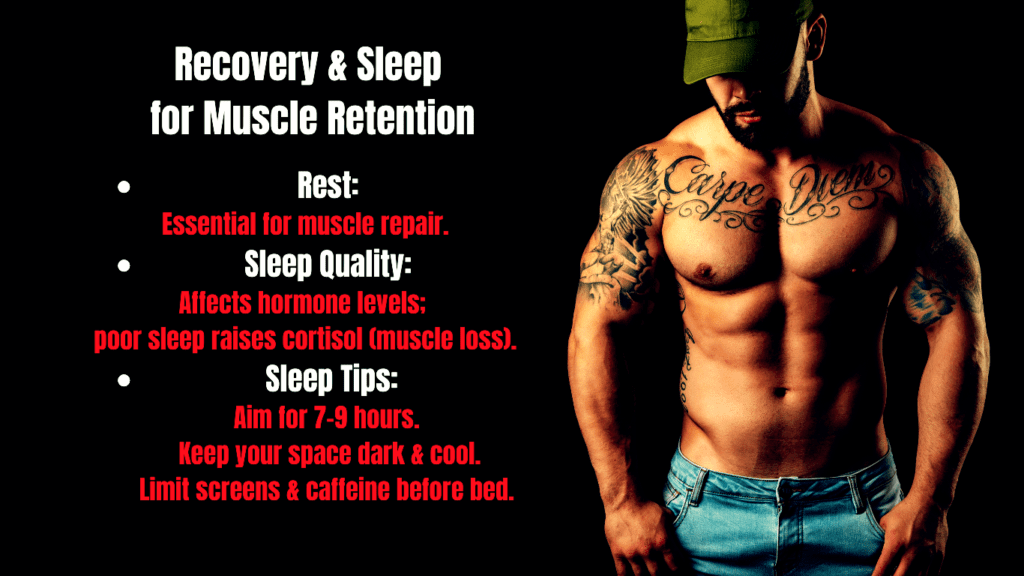
Why Rest Matters
Recovery is a critical component of any fitness regimen, particularly when you’re cutting and striving to maintain muscle mass. During periods of intense exercise and caloric deficit, your muscles experience stress and micro-tears. This is a natural part of the muscle-building process, but it’s during rest that the body repairs these micro-tears and builds new muscle tissue. Without adequate recovery, muscle repair is compromised, potentially leading to increased muscle breakdown.
When you’re in a caloric deficit, your body is already under additional stress. The process of rebuilding muscle tissue requires sufficient rest and recovery. If you skimp on rest, the body’s ability to repair and grow muscle is hindered, which can exacerbate muscle loss. Effective recovery ensures that muscles are adequately repaired and strengthened, reducing the risk of losing muscle mass during your cutting phase.
How to Prevent Muscle Loss While Cutting: Sleep and Muscle Preservation
Sleep plays an integral role in how to prevent muscle loss while cutting. Quality sleep impacts various physiological processes that are essential for muscle maintenance and overall health.
Poor Sleep and Cortisol: Sleep deprivation or poor sleep quality can lead to increased levels of cortisol, a hormone that is catabolic, meaning it breaks down muscle tissue. Elevated cortisol levels can hinder muscle growth and recovery, making it harder to preserve muscle mass while cutting. High cortisol levels also contribute to increased hunger and cravings, potentially leading to overeating or making poor food choices, which can further complicate the cutting process.
Growth Hormone and Testosterone: During deep sleep, the body produces growth hormone and testosterone, both of which are vital for muscle repair and growth. Growth hormone stimulates muscle protein synthesis, while testosterone helps maintain muscle mass and strength. Poor sleep reduces the secretion of these hormones, impairing muscle recovery and potentially leading to muscle loss.
Practical Tips for Sleep
To maximize the benefits of sleep and support how to prevent muscle loss while cutting, it’s important to implement strategies that enhance sleep quality. Here are some practical tips to help you achieve better sleep:
Create a Comfortable Sleep Environment: Your sleep environment plays a crucial role in the quality of your rest. Ensure your bedroom is dark, quiet, and cool. Consider using blackout curtains or an eye mask to block out light and earplugs or a white noise machine to reduce noise disturbances. A comfortable mattress and pillows that support proper alignment are also essential for restful sleep.
Establish a Consistent Sleep Schedule: Going to bed and waking up at the same time every day helps regulate your body’s internal clock, making it easier to fall asleep and wake up refreshed. Aim for 7-9 hours of sleep each night. Consistency is key—try to stick to your schedule even on weekends to maintain your sleep routine.
Manage Stress: High stress levels can negatively impact sleep quality and overall muscle preservation. Incorporate stress-management techniques into your daily routine, such as deep breathing exercises, meditation, or gentle yoga. Finding time to relax and unwind before bed can help calm your mind and prepare your body for restful sleep.
Limit Stimulants and Electronic Devices: Avoid consuming caffeine or other stimulants close to bedtime, as they can interfere with your ability to fall asleep. Similarly, reduce exposure to electronic devices with screens (e.g., smartphones, tablets, computers) before bed. The blue light emitted by screens can disrupt the production of melatonin, a hormone that regulates sleep.
Focus on Pre-Sleep Rituals: Developing a pre-sleep routine can signal to your body that it’s time to wind down. Consider engaging in relaxing activities, such as reading a book, taking a warm bath, or practicing relaxation techniques. Establishing a calming pre-sleep ritual can help transition your body into a restful state.
Stay Active During the Day: Regular physical activity can improve sleep quality, but avoid intense exercise too close to bedtime. Aim to complete your workouts at least a few hours before going to bed to give your body time to wind down.
By prioritizing recovery and sleep, you can significantly enhance your efforts to prevent muscle loss while cutting. Restful sleep and effective recovery strategies not only support muscle repair and growth but also improve overall health and well-being. Implement these practical tips to ensure that your body is in the best possible condition to maintain muscle mass throughout your cutting phase.
Recovery and sleep are often the unsung heroes in the quest for muscle preservation. Recognizing their importance and taking steps to optimize both can make a significant difference in how well you preserve muscle mass while cutting. Incorporate these strategies into your routine to support your goals and ensure a balanced and effective approach to cutting.
The Role of Hormones in Muscle Preservation: How to Prevent Muscle Loss While Cutting
Understanding how to prevent muscle loss while cutting involves more than just managing your diet and exercise; it also requires a grasp of how hormones affect muscle preservation. Hormones play a pivotal role in regulating muscle mass, and their balance can significantly impact your ability to maintain muscle during a cutting phase. This section will delve into the key hormones involved in muscle retention and provide practical advice on supporting hormonal health to achieve your cutting goals effectively.

Hormonal Impact: How to Prevent Muscle Loss While Cutting
Testosterone: Testosterone is one of the most critical hormones for muscle preservation. It plays a vital role in muscle protein synthesis, which is essential for muscle repair and growth. During a cutting phase, testosterone levels can naturally decline, especially if you are in a severe caloric deficit. Lower testosterone levels can lead to increased muscle breakdown and decreased muscle mass. Ensuring adequate levels of testosterone is crucial for maintaining muscle during your cut.
Growth Hormone: Growth hormone is another key player in muscle maintenance. It stimulates muscle protein synthesis and helps in the repair and growth of muscle tissues. During sleep, the body releases growth hormone, making good sleep essential for muscle preservation. When in a caloric deficit, growth hormone levels might be compromised, which can affect your ability to retain muscle mass.
Cortisol: Cortisol is often referred to as the stress hormone, and its levels can rise due to physical stress from intense workouts or psychological stress. Elevated cortisol levels can be catabolic, meaning they can contribute to muscle breakdown. High cortisol levels are particularly concerning during a cut, as they can counteract your efforts to preserve muscle mass and affect overall performance.
Insulin: Insulin is a hormone that helps regulate blood sugar levels and supports nutrient uptake into cells, including muscle cells. Proper insulin function is important for muscle preservation because it helps ensure that amino acids and other nutrients are efficiently delivered to muscle tissues for repair and growth. During a caloric deficit, insulin sensitivity can be affected, which might impact muscle maintenance.
How to Support Hormonal Health
To successfully navigate how to prevent muscle loss while cutting, it’s essential to support hormonal health by implementing strategies that help balance these critical hormones.
Avoid Severe Caloric Deficits: One of the most effective ways to support hormonal balance is to avoid drastic calorie reductions. A severe caloric deficit can lead to significant drops in testosterone and growth hormone levels, while also increasing cortisol. Instead, aim for a moderate caloric deficit—typically 15-20% below your maintenance level. This approach helps ensure that you’re losing fat while still providing your body with enough nutrients to support hormonal balance and muscle preservation.
Manage Stress: Stress management is crucial for maintaining balanced cortisol levels. High stress can lead to elevated cortisol, which can negatively impact muscle retention. Incorporate stress-reduction techniques into your daily routine, such as mindfulness practices, deep breathing exercises, or yoga. Regular physical activity, balanced with adequate recovery, can also help manage stress levels effectively.
Get Enough Dietary Fat: Dietary fats are essential for maintaining hormonal health. Fats contribute to the production of hormones like testosterone and help regulate overall hormonal balance. Include healthy fats in your diet, such as avocados, nuts, seeds, and fatty fish. Ensuring you get enough dietary fat can support hormone production and help preserve muscle mass during your cut.
Prioritize Quality Sleep: Quality sleep is vital for optimal hormonal function. During deep sleep, your body releases growth hormone and other hormones crucial for muscle repair and maintenance. Aim for 7-9 hours of restful sleep each night to support muscle preservation. Create a relaxing bedtime routine, maintain a consistent sleep schedule, and ensure your sleep environment is conducive to restful sleep.
Consider Nutrient Timing: Strategic nutrient timing can also impact hormonal balance. Consuming a balanced meal with protein and carbohydrates around your workouts can help regulate insulin levels and support muscle recovery. Avoid large meals right before bed to prevent potential disruptions in sleep and hormone production.
Monitor and Adjust: Regularly monitor your progress and how your body responds to your cutting phase. If you notice signs of excessive muscle loss or hormonal imbalances, consider adjusting your approach. This might involve re-evaluating your caloric deficit, increasing your nutrient intake, or making changes to your exercise routine.
In summary, understanding and managing hormonal health is a crucial aspect of how to prevent muscle loss while cutting. By focusing on strategies to support testosterone, growth hormone, cortisol, and insulin balance, you can enhance your efforts to maintain muscle mass throughout your cutting phase. Implementing practical measures such as avoiding severe caloric deficits, managing stress, incorporating healthy fats, and prioritizing sleep will help you preserve muscle and achieve your cutting goals more effectively.
Advanced Techniques for How to Prevent Muscle Loss While Cutting
In the pursuit of how to prevent muscle loss while cutting, incorporating advanced techniques can provide a significant boost to your efforts. While the fundamental strategies of balanced nutrition, proper training, and sufficient rest are crucial, additional methods like refeed days, diet breaks, and reverse dieting can further enhance muscle preservation and overall results. This section explores these advanced techniques and explains how they can be integrated into your cutting strategy.

Refeeds and Diet Breaks
Refeeds: A refeed day involves temporarily increasing your calorie intake, particularly from carbohydrates, to replenish glycogen stores and give your metabolism a short-term boost. When you’re in a caloric deficit, your glycogen levels can become depleted, leading to fatigue, decreased performance, and potential muscle loss. Refeed days help counteract these effects by restoring glycogen levels, which can improve workout performance and support muscle retention.
During a refeed day, you typically increase your carbohydrate intake while maintaining a moderate caloric surplus. This influx of carbs helps to refill muscle glycogen stores and can also have a positive impact on hormonal balance, particularly by boosting leptin levels. Leptin is a hormone that helps regulate hunger and metabolism. By temporarily elevating calorie intake, you can potentially stimulate metabolism and prevent the slowdown that often accompanies prolonged caloric restriction.
Diet Breaks: A diet break is a planned period of eating at maintenance calories, rather than continuing with a caloric deficit. This approach can last from a few days to a couple of weeks. The purpose of a diet break is to provide a psychological and physiological respite from the demands of dieting. It helps to reset hormonal levels, including those related to appetite and metabolism, and can prevent the negative effects of extended caloric restriction, such as muscle loss.
During a diet break, you return to your maintenance calorie level, which allows for replenishment of glycogen stores and gives your body a chance to recover from the stresses of cutting. This period can also improve adherence to your diet plan by providing a mental break from the rigidity of a caloric deficit. Incorporating diet breaks can help you maintain muscle mass and avoid the potential pitfalls of continuous dieting.
Reverse Dieting
Reverse Dieting: Once you’ve reached the end of your cutting phase, transitioning back to maintenance calories is crucial for preserving muscle mass and preventing unwanted fat gain. This process is known as reverse dieting. Instead of abruptly increasing your calorie intake back to maintenance levels, reverse dieting involves gradually increasing your calories over a period of time.
The primary goal of reverse dieting is to restore your metabolism to a more sustainable level while minimizing fat gain. After a period of caloric restriction, your metabolism may have slowed down, and increasing calories too quickly can lead to rapid fat gain. By incrementally increasing your calorie intake, you allow your metabolism to adjust and rebuild without overwhelming your system. This gradual approach helps to ensure that the muscle mass you’ve worked hard to preserve during your cut is maintained and that any additional weight gained is primarily lean mass rather than fat.
How to Implement Reverse Dieting: Start by adding small increments of calories to your daily intake, typically around 50-100 calories per week. Monitor your body’s response, including changes in weight, performance, and how your clothes fit. Adjust the rate of calorie increase based on your progress. The goal is to find a balance where you can return to maintenance calories without significant fat gain.
Reverse dieting also provides an opportunity to refine your dietary habits and focus on eating nutrient-dense foods that support overall health and well-being. Use this phase to reintroduce a variety of foods and establish a sustainable eating pattern that supports long-term goals.
Incorporating Advanced Techniques
Integrating advanced techniques like refeed days, diet breaks, and reverse dieting into your strategy for how to prevent muscle loss while cutting can offer additional benefits and help you maintain muscle mass more effectively. These methods provide a balanced approach to managing the demands of cutting while addressing potential issues like glycogen depletion, metabolic slowdown, and hormonal imbalances.
When incorporating these techniques, it’s important to listen to your body and adjust based on how you feel and the progress you’re making. Keep track of your performance, energy levels, and overall well-being to ensure that these strategies are supporting your goals and not counteracting them.
In summary, advanced techniques such as refeed days, diet breaks, and reverse dieting are valuable tools in your arsenal for how to prevent muscle loss while cutting. By strategically implementing these methods, you can enhance muscle preservation, support metabolic health, and achieve a more balanced and effective cutting phase. These approaches offer a way to optimize your results and transition smoothly from cutting to maintenance, ensuring that your hard-earned muscle is preserved and your progress is sustained.
Common Mistakes to Avoid in How to Prevent Muscle Loss While Cutting
Navigating how to prevent muscle loss while cutting effectively requires avoiding common pitfalls that can undermine your efforts. Cutting, or reducing body fat while maintaining muscle mass, demands careful planning and execution. Unfortunately, certain mistakes can derail your progress and lead to undesirable outcomes. This section will highlight key mistakes to avoid, including crash dieting, excessive cardio, and neglecting recovery, to help you stay on track and achieve your goals.
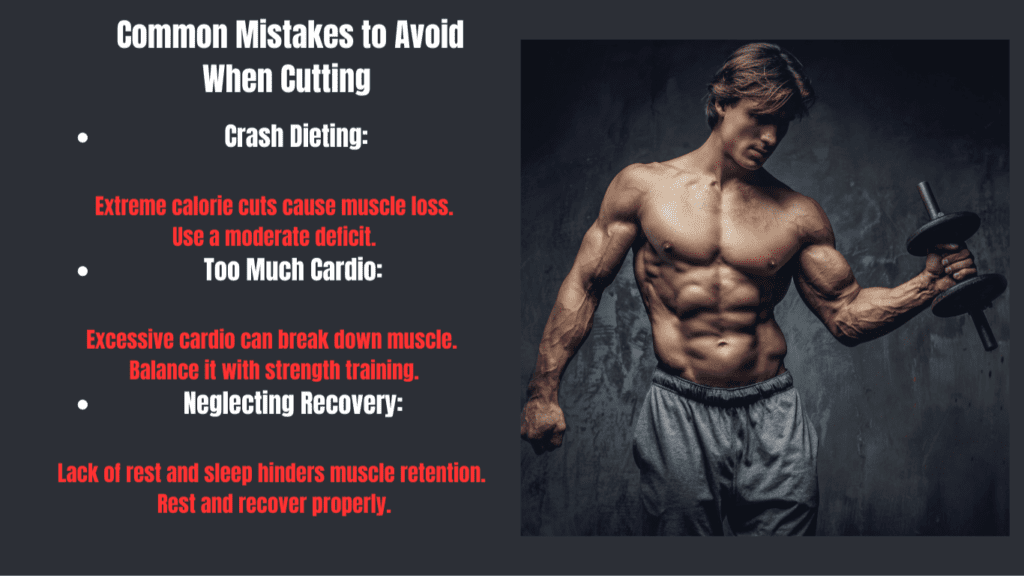
Crash Dieting
Crash Dieting: One of the most detrimental mistakes you can make while trying to figure out how to prevent muscle loss while cutting is resorting to crash dieting. Crash diets typically involve extreme caloric restrictions that significantly reduce your daily intake, sometimes to dangerously low levels. While these diets might offer rapid weight loss initially, they come with severe drawbacks.
Extreme caloric deficits not only decrease muscle protein synthesis but also increase muscle protein breakdown. When you severely restrict calories, your body is forced to break down muscle tissue for energy because it’s not getting enough from dietary sources. This muscle loss can negate your efforts to maintain strength and size during your cut. Additionally, crash dieting can lead to nutrient deficiencies, weakened immune function, and decreased energy levels, all of which can further hinder your ability to preserve muscle mass.
To avoid crash dieting, aim for a more moderate caloric deficit—typically around 15-20% below your maintenance level. This approach ensures a steady rate of fat loss while still providing your body with sufficient nutrients to support muscle retention. Balance is key; extreme measures often result in short-term gains but long-term setbacks.
How to Prevent Muscle Loss While Cutting: Too Much Cardio, Not Enough Lifting
Too Much Cardio: Another common mistake in how to prevent muscle loss while cutting is the overemphasis on cardio while neglecting strength training. Cardio exercises, such as running or cycling, are excellent for burning calories and improving cardiovascular health. However, excessive cardio can have unintended consequences for muscle mass.
When you do too much cardio, especially without adequate strength training, you risk accelerating muscle loss. This is because the body may start to use muscle tissue as an energy source when it is chronically deprived of calories and overexerted through excessive cardio. Additionally, extensive cardio can lead to increased cortisol levels, which can further contribute to muscle breakdown.
Prioritizing Strength Training: To counteract this, make sure that your workout routine includes a strong emphasis on resistance training. Weightlifting and other forms of strength training are crucial for signaling your body to preserve muscle mass during a cut. These exercises stimulate muscle protein synthesis and help maintain muscle size and strength. Aim to perform strength training workouts at least 3-4 times a week, focusing on compound movements that target multiple muscle groups.
A balanced approach that includes both cardio and strength training is optimal. Incorporate moderate amounts of cardio to support fat loss while prioritizing lifting to preserve and enhance muscle mass. This balanced approach will help you maintain muscle while effectively reducing body fat.
Neglecting Recovery
Neglecting Recovery: Recovery is often overlooked but is a critical component of how to prevent muscle loss while cutting. Recovery involves more than just rest days; it encompasses adequate sleep, proper nutrition, and appropriate training load management. Neglecting recovery can lead to overtraining, which can significantly impair muscle preservation and overall progress.
Sleep and Deload Weeks: Quality sleep is essential for muscle recovery and overall health. During sleep, your body repairs and builds muscle tissues, and growth hormone, which plays a vital role in muscle maintenance, is released. Chronic sleep deprivation can impair recovery, increase cortisol levels, and hinder your ability to retain muscle mass.
In addition to sleep, incorporate deload weeks into your training routine. A deload week is a period where you reduce the intensity and volume of your workouts to allow your body to recover from accumulated fatigue. This approach helps prevent overtraining, which can negatively impact muscle mass and overall performance. During a deload week, focus on lighter weights, reduced workout frequency, or alternative low-intensity exercises to give your muscles and joints a break.
In summary, avoiding common mistakes is crucial for how to prevent muscle loss while cutting. Steer clear of crash dieting, which can lead to muscle loss and other health issues. Balance your cardio with strength training to ensure muscle preservation while still benefiting from cardiovascular exercise. Lastly, prioritize recovery by getting adequate sleep and incorporating deload weeks into your routine to prevent overtraining. By avoiding these pitfalls, you can maintain muscle mass and achieve a successful cutting phase, ensuring that your hard-earned progress remains intact.
Practical Takeaways & Summary for How to Prevent Muscle Loss While Cutting
Understanding how to prevent muscle loss while cutting can significantly impact the effectiveness of your fat loss journey while preserving your hard-earned muscle. This final section will summarize the key strategies and offer actionable advice to help you succeed. We will also address common questions and concerns to ensure you have all the information you need.
Key Takeaways of How to Prevent Muscle Loss While Cutting
To effectively implement how to prevent muscle loss while cutting, remember these critical strategies:
- Avoid Extreme Caloric Deficits: Cutting calories too drastically can lead to muscle loss. Instead, aim for a moderate caloric deficit of around 15-20% below maintenance to ensure a steady fat loss while preserving muscle.
- Prioritize Protein Intake: Protein is crucial for maintaining muscle protein synthesis. Aim for a protein intake of 1.6-2.2 grams per kilogram of body weight per day. Distribute your protein intake throughout the day, focusing on post-workout and pre-sleep meals.
- Focus on Strength Training: Continue with regular resistance training to signal your body to maintain muscle mass. Include compound movements and lift heavy weights in the 6-12 rep range to preserve muscle during a cut.
- Limit Excessive Cardio: While cardio is beneficial for fat loss, too much can lead to muscle breakdown. Opt for moderate cardio, such as low-intensity steady state (LISS), and use high-intensity interval training (HIIT) sparingly.
- Incorporate Recovery Strategies: Prioritize sleep and recovery to prevent muscle breakdown. Ensure you get quality sleep and consider deload weeks to avoid overtraining.
- Support Hormonal Health: Maintain balanced hormone levels by avoiding severe caloric deficits, managing stress, and ensuring adequate fat intake.
- Use Advanced Techniques: Refeed days and diet breaks can help replenish glycogen stores and boost metabolism. Reverse dieting post-cutting can help ease your body back to maintenance calories and preserve muscle.
Cutting can be a challenging process, but it is entirely possible to do so without sacrificing muscle mass if you approach it correctly. By implementing the strategies outlined in this article, you can effectively manage your caloric deficit, support muscle preservation, and achieve your fitness goals. Remember, consistency and patience are key. Keep track of your progress, make adjustments as needed, and stay committed to your plan.
To maximize your success with how to prevent muscle loss while cutting, track your progress meticulously. Monitor changes in body composition, strength levels, and overall well-being. Stay consistent with your training and nutrition, and don’t be discouraged by minor fluctuations. Remember that progress takes time, and maintaining muscle mass during a cut is a testament to your dedication and hard work.

FAQ for How to Prevent Muscle Loss While Cutting
1. Should I lift heavier or lighter when cutting?
- When cutting, focus on lifting heavy weights in the 6-12 rep range to maintain muscle mass. Heavy lifting helps signal your body to preserve muscle despite the caloric deficit.
2. Can I build muscle while in a caloric deficit?
- Building muscle while in a caloric deficit is challenging but possible, especially if you’re new to training or returning after a break. Aim for a slight deficit and ensure adequate protein intake to support muscle growth.
3. How much protein do I need during a cut?
- Aim for 1.6-2.2 grams of protein per kilogram of body weight per day. This amount helps maintain muscle protein synthesis and supports muscle preservation during a caloric deficit.
4. How often should I incorporate cardio into my routine while cutting?
- Incorporate moderate amounts of cardio, such as 2-3 sessions per week. Choose low-intensity steady state (LISS) cardio to minimize muscle loss and use high-intensity interval training (HIIT) sparingly.
5. What is the best way to prevent muscle loss during a cut?
- The best way to prevent muscle loss includes maintaining a moderate caloric deficit, prioritizing protein intake, focusing on strength training, and ensuring adequate recovery.
6. How important is sleep in preserving muscle mass during a cut?
- Sleep is crucial for muscle preservation as it supports recovery and the release of muscle-building hormones like growth hormone. Aim for 7-9 hours of quality sleep per night.
7. What role do hormones play in muscle preservation?
- Hormones like testosterone and growth hormone support muscle maintenance, while high cortisol levels can promote muscle breakdown. Balancing hormones through proper nutrition, stress management, and adequate sleep is essential.
8. Can I include refeed days in my cutting plan?
- Yes, incorporating refeed days can help replenish glycogen stores, boost metabolism, and support muscle preservation. Use them strategically to avoid prolonged caloric deficits.
9. What is reverse dieting and how can it help after cutting?
- Reverse dieting involves gradually increasing your calorie intake post-cut to restore metabolism and minimize fat gain. It helps ease the transition back to maintenance calories while preserving muscle mass.
10. How can I manage stress to avoid muscle loss during a cut?
- Manage stress through relaxation techniques, adequate sleep, and a balanced diet. High stress levels can lead to elevated cortisol, which can negatively impact muscle preservation.
By adhering to these guidelines and avoiding common pitfalls, you’ll be well-equipped to navigate how to prevent muscle loss while cutting and achieve your fitness goals effectively. Stay informed, stay consistent, and your efforts will pay off in preserving muscle and achieving a lean, well-defined physique.


